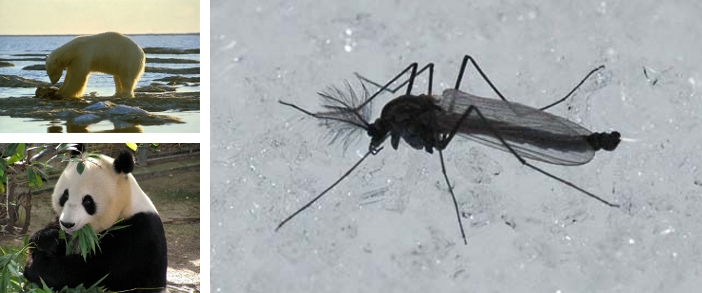By Jane Mazack
Exploring Daley Creek is a blog series that investigates the biological and physical processes at work in a small stream in Minnesota and what it means to consider rivers in a scientific framework. Follow along to learn more about life in the stream and its broader connections, both in the present and as we consider a future of climate change.
When you hear about the implications of climate change, they’re often accompanied by a heart-tugging picture of a polar bear on a tiny sliver of ice. This setup is designed to capture your emotions and gain popular appeal. Polar bears, like elephants, lions, and pandas, are charismatic megafauna; they’re large animals that catch humans’ attention.
L to R: Polar bear; giant panda; male adult midge (Species: Diamesa mendotae). Midge photo by the Chironomid Research Group, all rights reserved.
But environmental issues like climate change don’t just affect charismatic megafauna — and that’s why they are such important issues. They affect all aspects of ecosystems, from the largest species, like polar bears, to the smallest species, like midges.
The midge populations in Daley Creek are dependent on its seasonal water temperature patterns. Diamesa mendotae, a cold-adapted species of midge, only grows and develops for the few months when water temperatures are below 50°F; eggs laid in the spring are dormant all summer and only begin to grow when water temperatures drop again in the fall. Therefore, shifts in temperature patterns may cause dramatic shifts in midge growth and development.
This relatively “uncharismatic microfauna” is a key part of Daley Creek’s ecosystem. Midges aren’t large, cuddly, or fuzzy (except for their antennae), but they’re still important. The health and function of an ecosystem is a consequence of all its parts, not just its charismatic megafauna.
The writing and analysis of this blog series were conducted under the auspices of the John E. Sawyer Seminar “Making the Mississippi: Formulating New Water Narratives for the 21st Century”. Sawyer seminars are funded by the Andrew Mellon Foundation; further information about “Making the Mississippi” can be found here.
